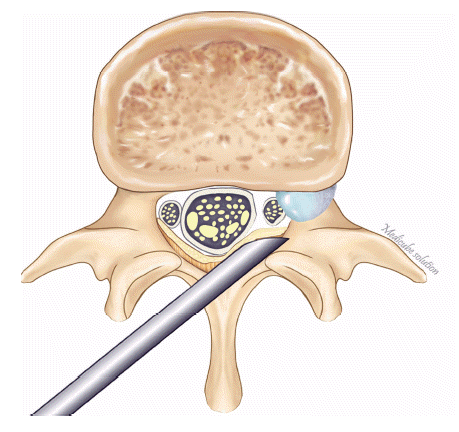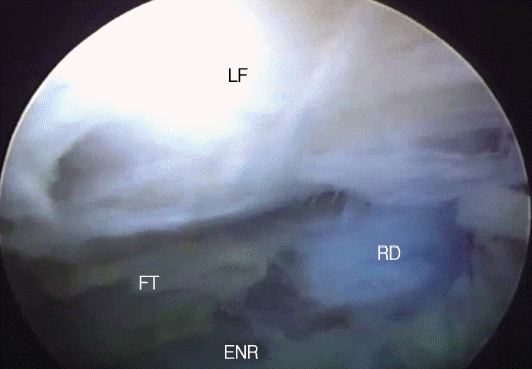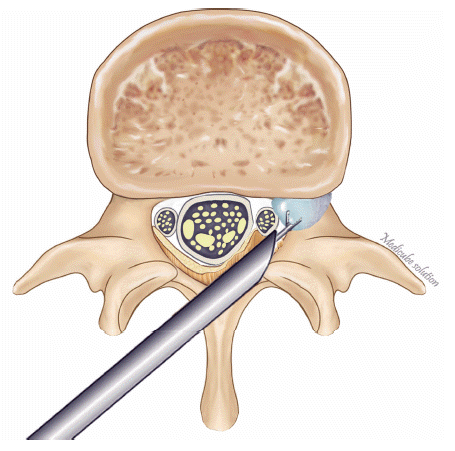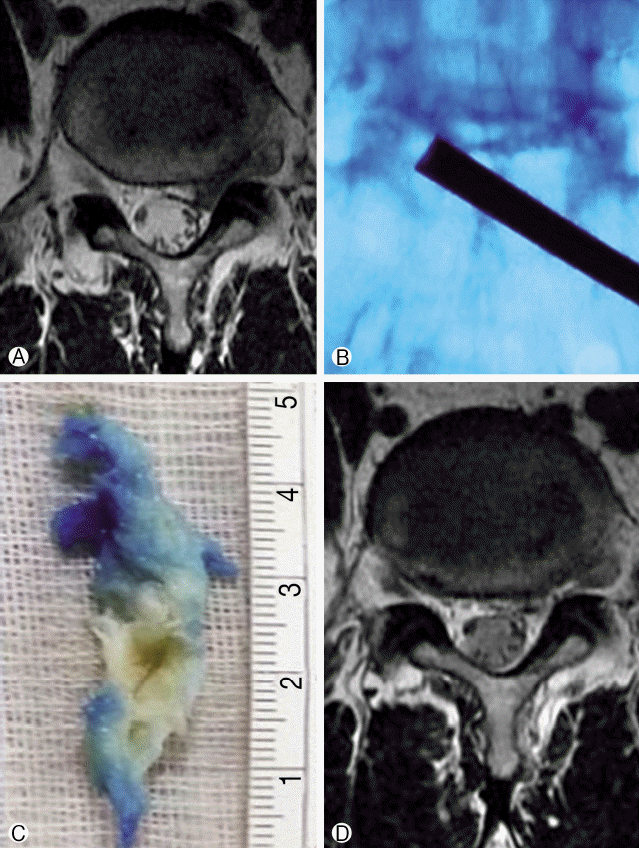INTRODUCTION
In a treatment of radiating pain related to the lumbar disc herniation, microscopic lumbar discectomy has been considered the gold standard [1]. However, due to the development of relevant equipment, such as a drill, forcep, laser, radiofrequency probe, and high-resolution optic endoscope, it has become possible to treat most lumbar disc herniations with percutaneous endoscopic lumbar discectomy (PELD) [4,5,9,12,13].
In cases of L5-S1 foraminal disc herniation with superior migration, both transforaminal and ipsilateral interlaminar approaches have technical difficulties. An appropriate endoscopic approach at the herniation has not been reported. In order to approach the contralateral foramen at the level, we attempted new approach that passed the interlaminar space from contralateral side to ipsilateral one of the lesion and present the approach.
CASE REPORT
Five patients complaining radiating pain were included between January 2013 and January 2014. The lesion of the patients was L5-S1 foraminal disc herniation with superior migration. The radiating pain of them was refractory to conservative treatment for more than six weeks. They underwent PELD via a contralateral interlaminar approach. The clinical outcomes were evaluated using visual analog scale (VAS) score and all patients were checked pre- and post-operative MRI to assess the decompression of the lesion.
1. Operative techniques
Prior to the operation, patients received preventive antibiotics and were prepared in a prone position on a radiolucent table. The operation was performed with conscious sedation using midazolam and fentanyl. In order to avoid injuries to exiting and traversing nerve roots during the approach, the operation was proceeded with continuous feedback from the patient. C-arm guidance was used to identify the L5-S1 disc space. The skin was marked at the midline of disc space. Discography was performed before insertion of working channel. 0.8% indigo carmine (Carmine, Korea United Pharmaceutical, Yoenki, Korea) mixed with contrast (Iobrix injection, Taejoon Pharm, Korea) were used for discography.
An 18-gauge spinal needle was inserted at the point which was about 2-3 cm away on the contralateral side of vertebral midline with an approximately 45-degree angle. After passing an interspinous ligament, the needle was docked at the medial border of inferior facet. A guide wire was inserted through the needle and then the needle was removed. An obturator was inserted just beyond the ligamentum flavum and then the wire was removed. A working channel was inserted through the obturator. An obturator was removed and then endoscope was inserted. The ligamentum flavum was splitted with a probe. Bevel of the working channel was penetrated through the splitted point of the ligamentum flavum and was rotated (Fig. 1). The splitted ligamentum flavum was pushed down, protecting a traversing nerve root and surrounding structures.
When the ligamentum flavum was splitted, a contralateral foraminal area was exposed. The epidural fat was dissected with a radiofrequency electrode (Ellman International, Hewlett, NY, USA). A blue-stained ruptured disc compressing an exiting nerve root was identified (Fig. 2). The ruptured disc was removed with endoscopic forceps (Fig. 3). After decompression of the lesion and bleeding control, the scope was removed. Decompression of the lesion was confirmed with post-operative MRI.
RESULTS
The average age of five patients was 55.8±10.04 years. Three of them were male, two were female. The average VAS score was reduced from 7.8±0.84 pre-operatively to 1.4±0.55 post-operatively (Table 1). All cases showed that the ruptured disc had been successfully removed on post-operative MRI. There were no complications such as dysthesia, hematoma, or infection. None of the cases needed any additional surgery.
1. Illustrative case
A 43-year-old man complained of a radiating pain to left leg, which had not responded to a conservative treatment. On pre-operative MRI, L5-S1 foraminal disc herniation with superior migration compressed left L5 nerve root (Fig. 4A). A working channel was inserted towards the medial border of inferior articular process of the lesion (Fig. 4B). The ligamentum flavum was splitted, blue-stained ruptured disc was identified and removed (Fig. 4C). Post-operative MRI showed that the ruptured disc had been successfully removed and left L5 nerve root was well decompressed (Fig. 4D).
DISCUSSION
Since Kambin et al. first introduced lumbar disc decompression via a posterolateral approach [7], there have been remarkable advances in percutaneous endoscopic lumbar disc surgery. With the development of various instruments related to spinal endoscopic surgery, now nearly all symptomatic lumbar disc herniation can be operated via endoscope.
As L5-S1 level has considerable anatomical features, such as high iliac crest, facet joint hypertrophy, relatively narrow foramen, and wide interlaminar space. Therefore, several approaches to ruptured disc at the L5-S1 level have been considered, such as transforaminal, ipsilateral interlaminar, and transiliac appoaches [3,6,12]. Choi et al. compared the transforaminal approach to the interlaminar approach in detail, depending on the location of lesion, but limited the lesion to intracanal disc herniation and did not include foraminal disc lesions [6].
In particular, it is difficult to approach L5-S1 foraminal disc herniation with superior migration with rigid endoscope, and such approaches have not been reported yet. Using an excessive cranial to caudal skin entry point due to the high iliac crest increases the possibility of encountering an existing nerve root injury. It is also difficult to approach L5-S1 foraminal disc herniation with superior migration via the ipsilateral interlaminar approach due to the inferior facet and laminar. Thus, microscopic lumbar discectomy via a paramedian transmuscular approach has been used for this type of lesion. However, microscopic approaches require partial facetectomy; if more than 40-50% of facet is removed, instability may arise, inducing postoperative pain [2,8].
The discs, facet joints, supraspinous ligaments, and paraspinal muscles of the lumbar spine are important structures that maintain a stability of segmental motion. Instability can be increased when these surrounding structures are damaged [10,11]. PELD via a contralateral interlaminar approach can maximally preserve these structures.
If the interlaminar space is relatively narrow, it might render an approach to superior migration difficult, as the laminar would block the trajectory. In such a case, an approach trajectory can be acquired by undercutting the inferior margin of the lesion-side facet using an endoscopic drill. Fortunately, in the present cases, we were able to approach the contralateral foramen without using an endoscopic drill. The outcomes were satisfying in all of cases, however the number of cases was small. Further study will be needed with more cases.
Since insertion of the working channel at a sharp angle may cause injury to the thecal sac, it is important to dock the working channel to the medial border of the inferior facet of lesions safely at an approximately 45-degree angle. In addition, splitting a ligamentum flavum without clarifying the boundaries of the bone and ligamentum flavum may cause exiting nerve root injury, thereby requiring attention.










